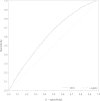Prediction of future labour market outcome in a cohort of long-term sick-listed Danes
- PMID: 24885866
- PMCID: PMC4055224
- DOI: 10.1186/1471-2458-14-494
Prediction of future labour market outcome in a cohort of long-term sick-listed Danes
Abstract
Background: Targeted interventions for the long-term sick-listed may prevent permanent exclusion from the labour force. We aimed to develop a prediction method for identifying high risk groups for continued or recurrent long-term sickness absence, unemployment, or disability among persons on long-term sick leave.
Methods: We obtained individual characteristics and follow-up data from the Danish Register of Sickness Absence Compensation Benefits and Social Transfer Payments (RSS) during 2004 to 2010 for 189,279 Danes who experienced a period of long-term sickness absence (4+ weeks). In a learning data set, statistical prediction methods were built using logistic regression and a discrete event simulation approach for a one year prediction horizon. Personalized risk profiles were obtained for five outcomes: employment, unemployment, recurrent sickness absence, continuous long-term sickness absence, and early retirement from the labour market. Predictor variables included gender, age, socio-economic position, job type, chronic disease status, history of sickness absence, and prior history of unemployment. Separate models were built for times of economic growth (2005-2007) and times of recession (2008-2010). The accuracy of the prediction models was assessed with analyses of Receiver Operating Characteristic (ROC) curves and the Brier score in an independent validation data set.
Results: In comparison with a null model which ignored the predictor variables, logistic regression achieved only moderate prediction accuracy for the five outcome states. Results obtained with discrete event simulation were comparable with logistic regression.
Conclusions: Only moderate prediction accuracy could be achieved using the selected information from the Danish register RSS. Other variables need to be included in order to establish a prediction method which provides more accurate risk profiles for long-term sick-listed persons.
Figures



Similar articles
-
Development and validation of a prediction model for long-term sickness absence based on occupational health survey variables.Disabil Rehabil. 2018 Jan;40(2):168-175. doi: 10.1080/09638288.2016.1247471. Epub 2016 Nov 10. Disabil Rehabil. 2018. PMID: 27830962
-
Early coordinated multidisciplinary intervention to prevent sickness absence and labour market exclusion in patients with low back pain: study protocol of a randomized controlled trial.BMC Musculoskelet Disord. 2013 Mar 13;14:93. doi: 10.1186/1471-2474-14-93. BMC Musculoskelet Disord. 2013. PMID: 23496897 Free PMC article. Clinical Trial.
-
Approaches for predicting long-term sickness absence. Re: Schouten et al. "Screening manual and office workers for risk of long-term sickness absence: cut-off points for the Work Ability Index".Scand J Work Environ Health. 2015 May 1;41(3):322-323. doi: 10.5271/sjweh.3483. Epub 2015 Feb 2. Scand J Work Environ Health. 2015. PMID: 25639964
-
Identifying labour market pathways after a 30-day-long sickness absence -a three-year sequence analysis study in Finland.BMC Public Health. 2023 Jun 7;23(1):1102. doi: 10.1186/s12889-023-15895-2. BMC Public Health. 2023. PMID: 37287018 Free PMC article.
-
Modeling sickness absence data: A scoping review.PLoS One. 2020 Sep 15;15(9):e0238981. doi: 10.1371/journal.pone.0238981. eCollection 2020. PLoS One. 2020. PMID: 32931519 Free PMC article.
Cited by
-
Worklife expectancy in a cohort of Danish employees aged 55-65 years - comparing a multi-state Cox proportional hazard approach with conventional multi-state life tables.BMC Public Health. 2017 Nov 15;17(1):879. doi: 10.1186/s12889-017-4890-7. BMC Public Health. 2017. PMID: 29141598 Free PMC article.
-
Neck-Shoulder Pain and Work Status among Former Sewing Machine Operators: A 14-year Follow-up Study.J Occup Rehabil. 2018 Mar;28(1):80-88. doi: 10.1007/s10926-017-9702-5. J Occup Rehabil. 2018. PMID: 28260173
-
Predicting the duration of sickness absence spells due to back pain: a population-based study from Sweden.Occup Environ Med. 2020 Feb;77(2):115-121. doi: 10.1136/oemed-2019-106129. Epub 2019 Dec 10. Occup Environ Med. 2020. PMID: 31822514 Free PMC article.
-
The Diffusion of Discrete Event Simulation Approaches in Health Care Management in the Past Four Decades: A Comprehensive Review.MDM Policy Pract. 2020 Jun 6;5(1):2381468320915242. doi: 10.1177/2381468320915242. eCollection 2020 Jan-Jun. MDM Policy Pract. 2020. PMID: 32551365 Free PMC article. Review.
-
Exploring predictors of welfare dependency 1, 3, and 5 years after mental health-related absence in danish municipalities between 2010 and 2012 using flexible machine learning modelling.BMC Public Health. 2023 Feb 2;23(1):224. doi: 10.1186/s12889-023-15106-y. BMC Public Health. 2023. PMID: 36732716 Free PMC article.
References
-
- Griffiths A. Ageing, health and productivity: a challenge for the new millennium. Work Stress. 1997;11:197–214. doi: 10.1080/02678379708256835. - DOI
-
- Madsen PK. How can it possibly fly?: The paradox of a dynamic labour market in a Scandinavian welfare state. Aalborg University: CARMA Research Papers; 2. CARMA; 2005. p. 38.
-
- Aust B, Helverskov T, Nielsen MB, Bjorner JB, Rugulies R, Nielsen K, Sorensen OH, Grundtvig G, Andersen MF, Hansen JV, Buchardt HL, Nielsen L, Lund TL, Andersen I, Andersen MH, Clausen AS, Heinesen E, Mortensen OS, Ektor-Andersen J, Orbaek P, Winzor G, Bultmann U, Poulsen OM. The Danish national return-to-work program--aims, content, and design of the process and effect evaluation. Scand J Work EnvironHealth. 2012;38(2):120–133. doi: 10.5271/sjweh.3272. - DOI - PubMed
-
- Lund T, Labriola M. Sickness absence in Denmark-research, results, and reflections. Scand J Work Environ Health Suppl. 2009;7:5–14.
MeSH terms
LinkOut - more resources
Full Text Sources
Other Literature Sources
Medical

